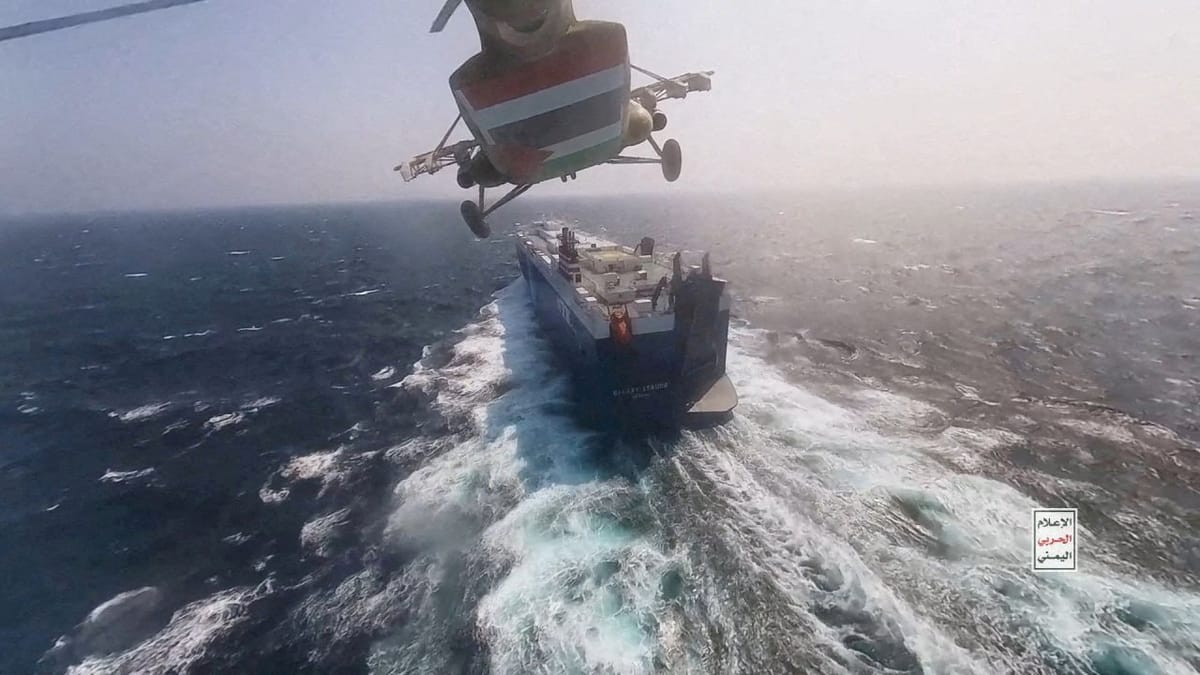What’s going on in the Red Sea?
The Red Sea is a significant waterway transferring hundreds of vessels and millions of containers through its waters every day.

A few minutes every morning is all you need.
Stay up to date on the world's Headlines and Human Stories. It's fun, it's factual, it's fluff-free.
The backstory: The Red Sea is a significant waterway connecting the Indian Ocean to the Mediterranean Sea, transferring hundreds of vessels and millions of containers through its waters every day. At the northern end of the Red Sea is the Suez Canal, one of the busiest and most important human-made waterways in the world. This route allows ships to go between the Indian Ocean and the Mediterranean without having to navigate around the southern tip of Africa. Every day, millions of products are transferred and moved between hundreds of countries and companies.
More recently: In November, the Houthis, a rebel group backed by Iran that controls parts of Yemen after years of conflict, started attacking international shipping vessels to support the Palestinian Islamist group Hamas in its conflict with Israel in Gaza. They initially said they were attacking ships they believed had ties to Israel, but many experts say they’ve moved onto commercial ships that don’t seem to have anything to do with Israel. They’ve been attacking these shipping lanes since November 19. Many shipping countries have begun to reroute and stop using the waterway as the situation continues.
The development: The Red Sea saw the Houthis launch their biggest missile and drone attack so far on Tuesday. The US and the UK worked together to shoot down over 20 drones and missiles targeting commercial ships. It was the Houthis’ 26th attack since mid-November.
The last time there was a supply chain disruption like this was during COVID. But now, with the Red Sea’s situation, including in some cases vessels seized and hostages captured, freight prices are set to jump. Containers are also limited as vessels have to reroute, therefore causing delays in goods arriving on time. For example, NEXT, the British multinational clothing brand has said that product shipments are now facing a longer delay because of ocean transit times. Vessel volume at the Suez Canal has fallen a little over 60% to an average of 5.8 vessels a day, according to Project44. And with Egypt owning this waterway, charging half a million US dollars per vessel, sometimes more, you can only imagine what this is doing for the country’s revenue.
Key comments:
“What we can share for now is that the situation in the Suez Canal will result in delays and may cause availability constraints for certain IKEA products. This is our main priority. In the meantime, we are evaluating other supply options to secure the availability of our products, and we continue to monitor the situation closely going forward,” said an IKEA spokesman late last year.
"An investigation into the incident is ongoing, and we will continue to pause all cargo movement through the area while we further assess the constantly evolving situation. In cases where it makes most sense for our customers, vessels will be rerouted and continue their journey around the Cape of Good Hope," said Maersk, one of the largest shipping companies in the world in a statement in early January.
“Let our message now be clear: we call for the immediate end of these illegal attacks and release of unlawfully detained vessels and crews,” said a joint statement from the US, Australia, Bahrain, Belgium, Canada, Denmark, Germany, Italy, Japan, Netherlands, New Zealand, Republic of Korea, Singapore and the UK, released by the White House earlier this month. “The Houthis will bear the responsibility of the consequences should they continue to threaten lives, the global economy, and free flow of commerce in the region’s critical waterways.”
Footage:
— Nawab Naeem Sial (@NawabNaeem8058) January 10, 2024
American warship that was targeted in the Red Sea yesterday….😳#GazaGenocide #Gaza #Yemen #Houthis #USA #Israel
pic.twitter.com/O0l4O6U0Ci




Comments ()